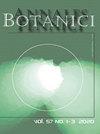亚洲的紫花藜及其近缘种:名称的长期误用
IF 0.9
4区 生物学
Q4 PLANT SCIENCES
引用次数: 1
摘要
直到20世纪90年代末和21世纪初,在中亚和西伯利亚的植物区系中,藜属的几种小叶物种(苋科s.lato/藜科s.stricto)经常被误名。两个广泛分布的分类群,匍匐C.petrum(现在被接受为C.karoi)和外阴C.vuloria,被普遍认可。然而,后者不存在于西伯利亚,只出现在亚洲西南部和中亚。再往北,“vulvaria”这个名字被误认为是两个物种,C.paliricum和C.grubovii LomonUotila sp.nova,特征是平卧茎分枝大部分基部和全缘,卵形叶片。帕米藜的特点是直立的茎沿全长分枝,三叶至全缘,叶片呈锯齿状,早期常被称为C.iljinii,并被误用为C.grubovii。它们可以通过其深裂的花被裂片和宽卵形的种子与女阴C.vulvaria和C.karoi区分开来;它们在生长习性和叶片性状上差异较大。卡氏藜分布非常广泛,从兴都库什和喜马拉雅山脉到亚洲北部和东北部,帕氏藜和格鲁博维藜分布在从兴都Kush、帕米尔和喜马拉雅山脉西部到西伯利亚南部、蒙古和中国中西部的高山上,后者在北方更常见。藜麦生长在比C.pamiricum更高的海拔高度,这两个物种通常都生长在比C.karoi高的海拔。提供了这些物种的钥匙、描述、图纸和分布图。本文章由计算机程序翻译,如有差异,请以英文原文为准。
Chenopodium pamiricum (Amaranthaceae) and Allied Species in Asia: The Prolonged Misapplication of Names
Up to the late 1990s and early 2000s, several small-leaved species of Chenopodium (Amaranthaceae s. lato/Chenopodiaceae s. stricto) were frequently misnamed in floras of central Asia and Siberia. Two widespread taxa, C. prostratum (now accepted as C. karoi) and C. vulvaria, were commonly recognized. However, the latter is absent from Siberia and occurs only in the southwestern central Asia. Further north the name ‘vulvaria’ was misapplied to two species, C. pamiricum and C. grubovii Lomon. & Uotila sp. nova, characterized by procumbent stem branched mostly basally and entire, ovate leaf blade. Chenopodium pamiricum, distinguished by erect stem branched along the whole length and trilobate to entire, trullate leaf blade, was earlier often known by the synonymous name C. iljinii and misapplied to C. grubovii. They can be distinguished from C. vulvaria and C. karoi by their deeply divided perianth lobes and broadly ovate seeds; from each other they mostly differ in the growth habit and leaf characters. Chenopodium karoi is very widely distributed, from the Hindu Kush and the Himalayas to northern and northeastern Asia, C. pamiricum and C. grubovii occur on high mountains from the Hindu Kush, Pamir, and western Himalayas as far as southern Siberia, Mongolia, and central and western China, the latter species being more common in the north. Chenopodium grubovii grows at higher elevations than C. pamiricum and both species usually grow at higher elevations than C. karoi. A key, descriptions, drawings, and distribution maps for these species are provided.
求助全文
通过发布文献求助,成功后即可免费获取论文全文。
去求助
来源期刊

Annales Botanici Fennici
生物-植物科学
CiteScore
1.30
自引率
14.30%
发文量
38
审稿时长
6-12 weeks
期刊介绍:
The journal publishes original, previously unpublished papers on plant and fungal:
• systematics, evolution, phylogeography, taxonomy and nomenclature,
• population biology and genetics,
• physiology and molecular biology,
• terrestrial and aquatic ecology (including effects of climate change),
• ecology and reproduction of invasive species as well as their effects on native populations,
• phytogeography and paleoecology.
 求助内容:
求助内容: 应助结果提醒方式:
应助结果提醒方式:


